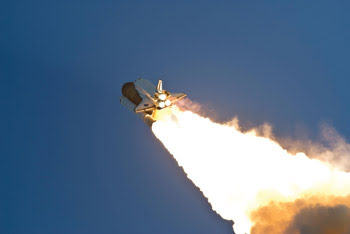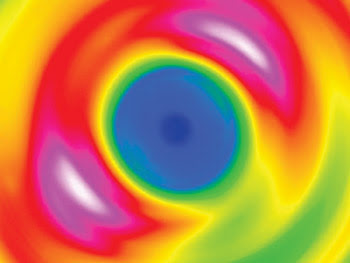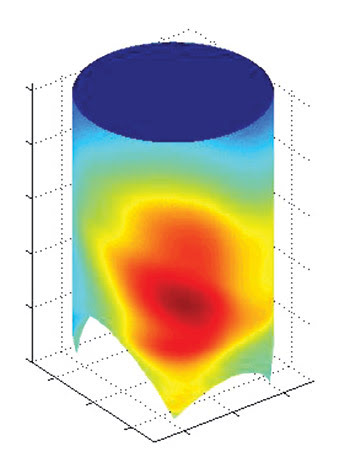IR imaging technology takes the temperatureof rocket engines and helps design a cooling system.
Ray Watts, Coastal Optical Systems, Jacob Chancery, Ad Astra Rocket Company, and Heiko Richter and Achim Zimmermann, JENOPTIK Laser, Optik, Systeme GmbH
Without a doubt, rocket engines are hot. Variable specific impulse magnetoplasma rockets fire continuously during a mission; therefore, a proper thermal system is needed to dissipate the waste heat and maintain a stable steady-state operating temperature.
To design an optimal lightweight cooling system, accurate measurement of the heat inside the engine is crucial. Ad Astra Rocket Company in Houston is developing a high-power, electric, variable specific impulse magnetoplasma rocket propulsion engine to enable faster and cheaper manned flights to Mars or to any future manned bases on the lunar surface. To make the heat measurements, the company used a remotely controlled IR-TCM 640 infrared camera from JENOPTIK of Jena, Germany. Operating in a vacuum, the camera had a spatial resolution of 640 × 480 pixels combined with excellent temperature resolution, which enabled exact mapping of the 2-D temperature field with negligible outgassing.

Ad Astra tested the camera in a magnetic field by turning the magnet coils on and slowly increasing the current. Magnetic field calculations based on the coil currents showed that the camera worked properly up to a field strength of around 1500 gauss. Measurement of the field strength with a hall probe corroborated the calculation.
Running in pulsed mode, the cameras were able to take a “before” picture, fire the engine for a while, take an “after” picture and then take a measurement to see how much the inside heated up. However, a newer rocket design will incorporate superconducting magnets and will run for prolonged periods, and the researchers won’t be able to turn off the magnets to take the images.
To meet the company’s requirement for live thermography in this high-flux environment, Coastal Optical Systems, a subsidiary of JENOPTIK, developed an optical design that moved the camera back into a region of lower field and still retained the optical field of view required for the measurements. The relay lens used is a high-efficiency, one-to-one 480-mm long-wavelength IR lens. It can be coupled with a second relay lens to provide a 960-mm distance that should enable thermal imaging inside high-magnetic-field environments.
Initially, the IR-TCM 640 camera was used in the modeling and testing of the VX100 engine, a 100-kW prototype. Now with the new relay lens, the researchers are ready for thermally imaging the next milestone, which will be the operation of the newest prototype of the rocket engine. The engine operates on 200 kW of electrical power and produces a few newtons of thrust with a specific impulse between 3000 and 5000 s. It also includes a superconducting magnet system, solid-state radio-frequency power technology and onboard computer control.

Figure 1. This thermograph shows heat distribution inside the plasma tube, viewed directly along the rocket axis.
Imaging 3-D distributions
To understand the rocket’s heat load, it’s necessary to look at the temperature changes over time. Based on these data, a proper cooling system can be designed that enables the rocket to work for months without overheating. The scientists made temperature measurements with good spatial resolution on the chamber walls of a cylindrical tube, which is like an ionization chamber, where the neutral gas propellant becomes ionized to form plasma (Figure 1). Thermocouple instrumentation is inadequate for this purpose for several reasons, so they used an IR camera and then, using a mathematical coordinate transformation, mapped the 2-D image onto the 3-D tube (Figure 2).

Figure 2. Here temperature data is mapped to the ionization chamber of the rocket engine.
The group has begun modeling the next prototype of the rocket engine and can thermally analyze it in a 10–7 torr vacuum chamber that simulates the deep-space environment that the rocket may be flying in within a decade. Thermal considerations are key in maximizing performance and in minimizing the weight allocated toward cooling systems.
Meet the authors
Ray Watts is sales manager at Coastal Optical Systems in Jupiter, Fla., Jacob Chancery is staff scientist of Ad Astra Rocket Company in Houston, Heiko Richter is international sales manager, infrared technology, and Achim Zimmermann is marketing engineer, both at JENOPTIK Laser, Optik, Systeme GmbH in Jena, Germany; e-mail: ray. [email protected]; [email protected]; [email protected].